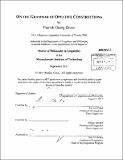| dc.contributor.advisor | Kai von Fintel and Sabine Iatridou. | en_US |
| dc.contributor.author | Grosz, Patrick Georg | en_US |
| dc.contributor.other | Massachusetts Institute of Technology. Dept. of Linguistics and Philosophy. | en_US |
| dc.date.accessioned | 2012-01-30T17:02:44Z | |
| dc.date.available | 2012-01-30T17:02:44Z | |
| dc.date.copyright | 2011 | en_US |
| dc.date.issued | 2011 | en_US |
| dc.identifier.uri | http://hdl.handle.net/1721.1/68913 | |
| dc.description | Thesis (Ph. D.)--Massachusetts Institute of Technology, Dept. of Linguistics and Philosophy, 2011. | en_US |
| dc.description | Cataloged from PDF version of thesis.Sabine Iatridou. | en_US |
| dc.description | Includes bibliographical references (p. 391-407). | en_US |
| dc.description.abstract | The primary aim of this dissertation is to present an analysis for so-called optative constructions, clauses that express a wish, hope or desire without containing a lexical item that means 'wish', 'hope' or 'desire'. A secondary aim is to contrast optative constructions with so-called polar exclamatives, clauses that express surprise, shock or dismay at a given fact without containing a lexical item that means 'surprise', 'shock' or 'dismay'. The goal is to better understand the way in which syntax, semantics and pragmatics interact in order to yield the meanings and uses that these constructions have. The core claim is that we can understand optative constructions by virtue of exploring three properties that they share. First, I argue that optatives (and polar exclamatives) contain a generalized exclamation operator EX, which serves to express an emotion towards the status of the modified proposition on a contextually provided scale. Second, I argue that semantic mood (including factivity and counterfactuality) is encoded in a distinguished Mood head, the content of which co-determines both morphological mood and the material that overtly surfaces in the position of C. Third, I argue for a generalized analysis of prototypical particles, including non-exclusive ONLY, concessive AT LEAST and unstressed DOCH. My analysis treats these particles as truth-conditionally vacuous presupposition triggers, which interact with optativity in three different ways. First, they convey additional information with respect to the modified proposition. Second, they eliminate alternative readings for an ambiguous clause, due to incompatibility. Third, this disambiguating role makes them ideal licensors for a marked utterance type. Chapter 1 of this dissertation is an introductory chapter that presents the core proposal in a nutshell. After this coarse overview, chapter 2 reviews some basic definitions and background on optatives and polar exclamatives. Subsequently, I proceed to a presentation of my entire system in chapter 3. The following chapters discuss each of the three core parts in turn, starting with the EX operator in chapter 4, followed by semantic mood in chapter 5 and finally I discuss particles in chapter 6. Chapter 7 concludes. | en_US |
| dc.description.statementofresponsibility | by Patrick Georg Grosz. | en_US |
| dc.format.extent | 407 p. | en_US |
| dc.language.iso | eng | en_US |
| dc.publisher | Massachusetts Institute of Technology | en_US |
| dc.rights | M.I.T. theses are protected by
copyright. They may be viewed from this source for any purpose, but
reproduction or distribution in any format is prohibited without written
permission. See provided URL for inquiries about permission. | en_US |
| dc.rights.uri | http://dspace.mit.edu/handle/1721.1/7582 | en_US |
| dc.subject | Linguistics and Philosophy. | en_US |
| dc.title | On the grammar of optative constructions | en_US |
| dc.type | Thesis | en_US |
| dc.description.degree | Ph.D. | en_US |
| dc.contributor.department | Massachusetts Institute of Technology. Department of Linguistics and Philosophy | |
| dc.identifier.oclc | 773614730 | en_US |
